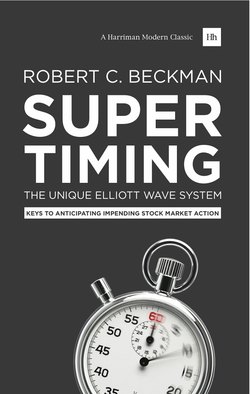Оглавление
Robert C. Beckman. Supertiming: The Unique Elliott Wave System
Publishing Details
Follow us, Like us, Add us
Publisher’s Preface, 1979
Introduction
One: The Origins of the Wave Principle
First contacts with Wall Street
Elliott and the Economists
The Grand Super Cycle
The Five-wave Concept
The Need to be a Genius?
Two: Reality in the Stock Market
$2,000 to $1,000,000
The Future not the Past
Cyclical Nature of the Market
Time Frame Relative – not Fixed
Classification of Waves
Three: Elliott… Pure and Simple
A Rhythmic Pattern of Waves
Elliott’s Five Basic Tenets
Bull Market – Bear Market
Ground Rules
Application to Investment Strategy
Probabilities not Absolutes
Practice Runs
Four: “Like a Circle in a Spiral, a Wheel within a Wheel”
The Wave Count
Breakdown of Primary Market Cycle
Pivotal Points
1984?
Normality and Variations
The Market is Always Right
Improving Investment Performance
Five: The Fibonacci Summation Series
The Series
W. D. Gann’s Numerical Approach
The Fibonacci Series in Art and Nature
Examples from Nature’s Law
Fibonacci and Cyclical Behaviour
Brilliant… or Ludicrous?
Open Mind – Successful Investment
Six: Applying the Fibonacci Series
Choice of Stock Exchange Data
A Psychological Phenomenon
Pattern
Time
Ratio
Calculations and Examples
The “Non-Absolute” Nature of Elliott
Stock Market History and the Summation Series
Seven: The Trend Channel
Logarithmic and Arithmetic Scales
Forecasting using Trend Channels
Frames of Reference, not Predictions
Deviations from “Normative” Behaviour
F.T.30, January 1975-February 1976
Eight: Elliott, Inflation and the Fifth Wave
Inflation in Britain
Inflation in the U.S.A. and Fibonacci
Early Warnings of Inflation
Extensions
Extensions of Extensions
Retracements and Double Retracements
Double Retracement and the Extended Fifth Wave
Nine: Incorrigible Behaviour
Extensions in the Corrective Phase
Corrective Wave Formations – “Zigzag”
Maximum Corrective Action
Use in Investment Strategy
Further Corrective Wave Formations
The “Flat”
“Irregular Corrections”
Ten: “Double Threes”, “Triple Threes”, “Horizontals”, “Triangles”… and all that!
Complex Corrections
Triangles and Horizontals
The Tension in the Triangle
Enlargement of Corrections
Use of the Time Factor
Action after the Corrective Wave
Eleven: The Finishing Touches
Breakdown of the Impulse Waves
Elliott’s Theory of Alternation
Erroneous Counting
“Failures”
“Thrusts”
Volume
Moving Averages
Ancillary Indicators
Twelve: Practical Application of the Wave Principle
Terminal Endings
The Next Ten Years
Sequence for Selling
Trading Intermediate Term Movements
Confirmation of Terminal Junctures
Applications to Individual Share Price Movements
The Final Word
Appendix: “The Wave Principle”
Introducing “The Wave Principle”
Historical Significance
The Wave Principle: Part II
Completed Movement
Price Ranges Used
Outside Influences
The Wave Principle: Part III
The Wave Principle: Part IV
The Wave Principle: Part V
Orderly Decline
Bearish Indication?
The Wave Principle: Part VI
The Wave Principle: Part VII
The Wave Principle: Part VIII
The Wave Principle: Part IX
The Wave Principle: Part X
The Wave Principle: Part XI
Wave Characteristics
Critical Points
The Wave Principle: Part XII
Bibliography
Now add to your trading library
